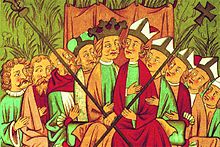Diferencia entre revisiones de «Veche»
m Empiezo a traducir de http://en.wikipedia.org/w/index.php?title=Veche&oldid=339879309 para expandir Veche |
m Traduzco otro párrafo (fue muy tentador) |
||
| Línea 15: | Línea 15: | ||
== Veche in the Novgorod and Pskov Republics == |
== Veche in the Novgorod and Pskov Republics == |
||
{{AP|Veche de la República de Nóvgorod}} |
|||
| ⚫ | |||
The veche was the highest [[legislative|legislature]] and [[judicial authority]] in the [[Novgorod Republic|Republic of Novgorod]] until 1478, when the city was [[Conquest of Novgorod|brought under the direct control]] of Grand Prince [[Ivan III]] (1462-1505). In its "Little Brother", [[Pskov Republic|Pskov]] the veche continued until 1510, when that city was taken over by Grand Prince [[Vasily III of Russia|Vasilii III]] (1505-1533). |
|||
| ⚫ | |||
La veche era la más alta [[autoridad judicial]] y [[poder legislativo]] in la [[República de Nóvgorod]] hasta 1478, cuando la ciudad fue [[Conquista de Nóvgorod|conquistada]] por el Gran Príncipe [[Iván III de Rusia|Iván III]] (1462-1505). Su "hermano menor", [[República de Pskov|Pskov]], continuó con las veches hasta 1510, cuando la ciudad fue tomada por el Gran Príncipe [[Basilio III de Moscú|Basilio III]] (1505-1533). |
|||
The traditional scholarship goes on to argue that a series of reforms in 1410 transformed the veche into something similar to the public assembly of [[Venice]]; it became the [[Commons]] or lower chamber of the parliament. Аn upper [[Senate]]-like [[Sovet gospod|Council of Lords]] (''sovet gospod'') was also created, with title membership for all former city magistrates (''[[posadnik]]s'' and ''[[tysyatsky]]s''). Some sources indicate that veche membership may have became full-time, and parliament deputies were now called ''vechniks''. Some of the more recent scholars call this interpretation into question. |
The traditional scholarship goes on to argue that a series of reforms in 1410 transformed the veche into something similar to the public assembly of [[Venice]]; it became the [[Commons]] or lower chamber of the parliament. Аn upper [[Senate]]-like [[Sovet gospod|Council of Lords]] (''sovet gospod'') was also created, with title membership for all former city magistrates (''[[posadnik]]s'' and ''[[tysyatsky]]s''). Some sources indicate that veche membership may have became full-time, and parliament deputies were now called ''vechniks''. Some of the more recent scholars call this interpretation into question. |
||
Revisión del 00:56 5 feb 2010

Veche (ruso: вече, polaco: wiec, ucraniano: віче) fue una asamblea popular de los pueblos eslavos de la época medieval, a menudo comparado con los parlamentos. La veche también puede ser comparada con la ekklesía de Atenas y otras polis de la antigua Grecia.
La palabra "veche/wiec" deriva de la raíz proto-eslava *vēt-, cuyo siginificado es "consejo" o "hablar". La derivación semántica que da el significado a la palabra es paralela a la de la palabra "parlamento".
Kievan Rus
The East Slavic veche/viche is thought to have originated in tribal assemblies of Eastern Europe, thus predating the Rus' state. It is not clear whether it was a purely Slavic development or it was based on the model of the Varangian Ting. The authority of the veche appears to have been stronger in the north, where the tradition of the Rus' Khaganate lived on.[cita requerida]
The earliest mentions of veche in East European chronicles refer to examples in Belgorod Kievsky in 997, Novgorod the Great in 1016 and in Kiev in 1068. The assemblies discussed matters of war and peace, adopted laws, and called for and expelled rulers. In Kiev, the veche was summoned in front of the Cathedral of St Sophia.
In Ukraine, the town viche was simply a gathering of community members to inform everybody of important events (vich-na-vich - eye-to-eye) and come up with a collective planning for the near future.
Veche in the Novgorod and Pskov Republics

La veche era la más alta autoridad judicial y poder legislativo in la República de Nóvgorod hasta 1478, cuando la ciudad fue conquistada por el Gran Príncipe Iván III (1462-1505). Su "hermano menor", Pskov, continuó con las veches hasta 1510, cuando la ciudad fue tomada por el Gran Príncipe Basilio III (1505-1533).
The traditional scholarship goes on to argue that a series of reforms in 1410 transformed the veche into something similar to the public assembly of Venice; it became the Commons or lower chamber of the parliament. Аn upper Senate-like Council of Lords (sovet gospod) was also created, with title membership for all former city magistrates (posadniks and tysyatskys). Some sources indicate that veche membership may have became full-time, and parliament deputies were now called vechniks. Some of the more recent scholars call this interpretation into question.
The Novgorod assembly could be presumably summoned by anyone who rung the veche bell, although it is more likely that the common procedure was more complex. The whole population of the city - boyars, merchants, and common citizens - then gathered at Yaroslav's Court or in front of the Cathedral of Holy Wisdom (the latter called a Vladychnoe veche - "An Archbishop's Veche," since it was called in front of the cathedral). The veche bell was a symbol of republican sovereignty and independence and for this reason, Ivan III carted it off to Moscow when he took control of the city, to show that the old way of doing things was at an end.
Separate assemblies could be held in the boroughs or "Ends" of Novgorod. In Pskov the veche assembled in the court of the Trinity cathedral.
Poland

Según las crónicas de Gallus Anonymus, el legendario primer líder de Polonia, Siemowit, fue elegido por una wiec. La idea de wiec derivó en 1182 como el parlamento polaco denominado Sejm.
References
- Michael C. Paul, "The Iaroslavichi and the Novgorodian Veche: A Case Study on Princely Relations with the Veche," Russian History (2004).
Véase también
- Thing (asamblea popular escandinava)
- Sejm (parlamente polaco)
- Rada (parlamento de Ucrania)
- Duma y Zemsky Sobor (parlamentos rusos)
[[Categoría:Historia de Polonia]] [[Categoría:República de Nóvgorod]] [[Categoría:Rus de Kiev]] [[be:Веча]] [[bg:Вече (славянско събрание)]] [[cs:Věče]] [[de:Wetsche]] [[en:Veche]] [[et:Veetše]] [[hu:Vecse]] [[it:Veče]] [[nl:Vetsje]] [[pl:Wiec]] [[ru:Вече]] [[uk:Віче]]
